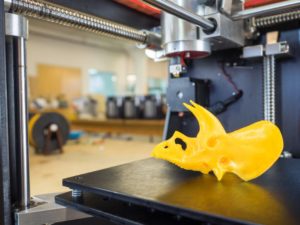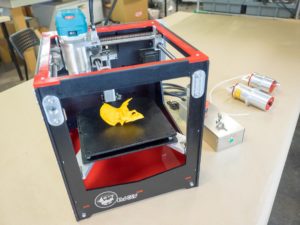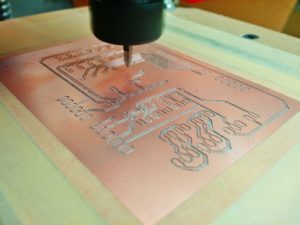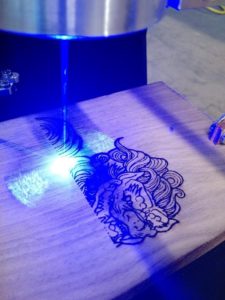 3D printing, across its varied technologies, offers a remarkable manufacturing technique seeing rising adoption across the world — and one that will not in and of itself offer disruption in the form of total replacement of tradtitional manufacturing technologies. Hybrid manufacturing offers a more holistic view of an end-to-end production solution, utilizing both subtractive and additive manufacturing technologies in a complementary process. While often this comes in the form of separate machines (e.g., a metal 3D printed part finished via CNC), we’re more frequently seeing all-in-one solutions arise that bring processes together into a single machine.
3D printing, across its varied technologies, offers a remarkable manufacturing technique seeing rising adoption across the world — and one that will not in and of itself offer disruption in the form of total replacement of tradtitional manufacturing technologies. Hybrid manufacturing offers a more holistic view of an end-to-end production solution, utilizing both subtractive and additive manufacturing technologies in a complementary process. While often this comes in the form of separate machines (e.g., a metal 3D printed part finished via CNC), we’re more frequently seeing all-in-one solutions arise that bring processes together into a single machine.
For all the benefits of an all-in-one machine bringing together subtractive and additive manufacturing into a single footprint on a factory floor, barriers to adoption echo refrains familiar to many new technological offerings. Particularly for smaller enterprises, bringing in new machinery can be a daunting undertaking, and many manufacturers are risk-averse. Fortunately, the makers of many hybrid offerings realize this barrier and are seeking to educate and elucidate.
Pittsburgh-based BoXZY, co-founded by brothers Joel and Justin Johnson two years ago, offers their hybrid tool — as well as a well-thought-out ethos behind hybridity and what it means for any piece of manufacturing equipment to be not just a tool, but one based on communication. I met CEO Joel in a Pittsburgh makerspace earlier this year, as we discussed philosophies of manufacturing. He has since shared updates on high-strength capabilities of the tool, and now Joel is back with some interesting thoughts on hybridity and the nature of tools in manufacturing.
Rather than try to sum up his industry insider perspective, the following are thoughts directly from BoXZY CEO Joel Johnson.
Hybrid 3D printers, like BoXZY, may seem like the epitome of feature creep. But, there are profound reasons for the hybrid design. It’s naive to assume that adding another CNC capability provides a buyer a psychologically persuasive reason to buy. In fact, that’s not true.
There are many reasons to avoid selling a hybrid tool. Hybrid tools give potential customers more reason to feel intimidated. It’s like saying, ‘Hey! Look here’s one thing that you’re already afraid to learn—let me throw something else terrifying at you!’
On the contrary, having all the capabilities in the same hybrid 3D printer actually makes everything easier to learn. You just learn one interface and one machine to do three. However, that’s not the way it’s typically perceived, most especially by new users. The hedonistic math here is subtractive. The more you add, the less people want it.
We knew this when we designed BoXZY, and we still made BoXZY a hybrid 3D printer. This sounds like madness, and maybe it is. But, we didn’t imagine ourselves designing another tool just to make stuff. We created a communication device. For me, it’s the link between people that matters more than the machine. We were trying to create a better link.
We set out to create the real-time delivery of mechanical designs. Adding CNC milling and laser engraving to 3D printing was about adding new ‘inks’ to the communication. If this was inkjet printing, BoXZY is full-color and regular 3D printing is black-and-white.
With hybrids, you ‘print’ in more materials than just plastic. With BoXZY, your ‘inks’ are steel, wood, titanium, PCBs, leather, and even the stones you find in your yard. You can use almost any material as ‘ink’ so that your design communications aren’t limited. 3D printing communicates impossible shapes in plastics. CNC carving and laser engraving empowers you to transport everything else.
Material matters. Most mechanical or electrical designs require more than plastic. If you’re to create and communicate most of your designs, you need to be able to shape and translate a wider array of materials. A load bearing component may require titanium or steel, and your electrical component might require a PCB board, while all of those may need to be enclosed in a plastic insulator. A hybrid, like BoXZY, allows you to communicate it all.
If you conceive of fabrication tools differently—as communication devices—you start to see differently. You start to see that standardization across locations matters.
Standardization means better, faster communications. If you have the same BoXZY in different locations, you can communicate the exact design with the exact setup—fast. Everything’s identical. Same calibration, same setup, same abilities. You have all the same ‘inks’ printing exactly the same way.
Even a completely untrained person could receive exact material solutions from an expert. All they need to do is copy the setup and use the file. They don’t need to know the principles, the settings, or have any of the skills—they just need to copy the expert.
With the same BoXZY across different locations, there aren’t days or weeks of troubleshooting to get your different tools to align. Push this, set that, hit print. There’s perfect fidelity between designs. BoXZY is as close as we get to Star Trek transporters.
Tools are just a means to a human end, not an end in themselves. Tools should be seen as a way to enrich human connection and collaboration, and BoXZY is designed to create more effective collaboration. BoXZY Is designed to fully equip the communication with the ability to send complete mechanical designs across vast distances using a single solution.
 My desire was to see designers from economically secure nations create solutions that ultilize local materials in developing nations. I was inspired by the problem that industrial and post-industrial nations have creating sustainable solutions for developing nations. The old model was a failure. Charities sent our tech to nations that couldn’t sustain that technology for long. The machines would break down and the locals would have no way to fix those machines. Water pumps, medical devices and infant incubators would fail and become a useless artifacts of past aid. BoXZY equips designers from industrial nations and post-industrial nations to design complete, sustainable technology for developing nations with the materials that are most available in those developing nations. And, BoXZY is designed to equip people in those developing nations with the ability to build and sustain technologies designed in industrial nations and post industrial nations.
My desire was to see designers from economically secure nations create solutions that ultilize local materials in developing nations. I was inspired by the problem that industrial and post-industrial nations have creating sustainable solutions for developing nations. The old model was a failure. Charities sent our tech to nations that couldn’t sustain that technology for long. The machines would break down and the locals would have no way to fix those machines. Water pumps, medical devices and infant incubators would fail and become a useless artifacts of past aid. BoXZY equips designers from industrial nations and post-industrial nations to design complete, sustainable technology for developing nations with the materials that are most available in those developing nations. And, BoXZY is designed to equip people in those developing nations with the ability to build and sustain technologies designed in industrial nations and post industrial nations.
The power of innovation lies in the human network. The more fully innovators can communicate mechanical designs, the greater the innovation. Focusing on the network creates an exponential design path and a greater distribution of hardware solutions. My design focus is on the network not just the machine. BoXZY serves the network. We designed BoXZY for the network’s needs. In America and Europe, that means rapid innovation and faster development. In developing nations, that means having the basics of health and wealth fare.
As Joel notes, creation is about more than a technology or a tool — it comes down to the creator to innovate.
We’ll be hearing more in 2018 from BoXZY as the company has some interesting projects in the works, with details we’re excited to share.
[Images provided by BoXZY]
Subscribe to Our Email Newsletter
Stay up-to-date on all the latest news from the 3D printing industry and receive information and offers from third party vendors.
You May Also Like
Profiling a Construction 3D Printing Pioneer: US Army Corps of Engineers’ Megan Kreiger
The world of construction 3D printing is still so new that the true experts can probably be counted on two hands. Among them is Megan Kreiger, Portfolio Manager of Additive...
US Army Corps of Engineers Taps Lincoln Electric & Eaton for Largest 3D Printed US Civil Works Part
The Soo Locks sit on the US-Canadian border, enabling maritime travel between Lake Superior and Lake Huron, from which ships can reach the rest of the Great Lakes. Crafts carrying...
Construction 3D Printing CEO Reflects on Being Female in Construction
Natalie Wadley, CEO of ChangeMaker3D, could hear the words of her daughter sitting next to her resounding in her head. “Mum, MUM, you’ve won!” Wadley had just won the prestigious...
1Print to Commercialize 3D Printed Coastal Resilience Solutions
1Print, a company that specializes in deploying additive construction (AC) for infrastructure projects, has entered an agreement with the University of Miami (UM) to accelerate commercialization of the SEAHIVE shoreline...







































